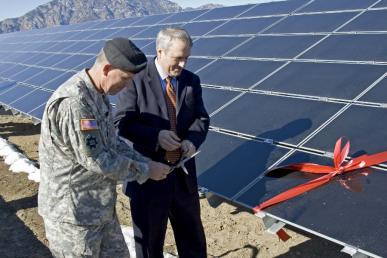Four Ways the U.S. Military Can Adopt Clean Energy for National Security

At the U.S. Defense Department, the multiple national security threats created by sea level rise and severe weather command daily attention; climate change has been on its radar for years. The recently published Quadrennial Defense Report (QDR), an assessment of U.S. defense readiness, addresses the growing threat that climate change poses to military capabilities and global operations. Adding to that, the newly released Intergovernmental Panel on Climate Change report states that extreme weather events will begin occurring more frequently across the globe. As first responders in the wake of extreme weather events, the U.S. military will be called upon to provide emergency support and services for a large portion of them.
The timing of these reports highlights a growing defense challenge but also provides an opportunity for the Defense Department to lead from the front in climate change mitigation and adaptation.
The military’s success in preparing for and mitigating climate change impacts will depend in large part on where it gets energy and how smartly it uses energy, especially amid budget constraints. Consider this: the Defense Department is the single largest energy consumer in the United States, despite accounting for less than one percent of total domestic use.
Each of the branches – Air Force, Army, Navy, and the Marine Corps – is making significant progress to reduce greenhouse gas pollution, but more must be done to meet energy goals and prepare for the global consequences of climate change. To do this, the Defense Department should:
- Play a larger role in creating a smarter, more resilient U.S. electricity grid. The security risks of an aging and inadequate power grid are direct threats to military capabilities. Case in point: Joint Base McGuire-Dix-Lakehurst in New Jersey served multiple logistical and emergency response functions during Superstorm Sandy – but parts of the base lost power during the storm. In fact, between 2010 and 2011, power outages on domestic Army bases alone more than doubled. Military bases that are proactive, rather than reactive, in their relationships to the electricity grid will be more resilient to extreme weather and grid attacks.
- Increase energy efficiency. According to the Pew Charitable Trust, 20 percent of the Defense Department’s energy consumption occurs on domestic bases, where the annual energy bill tops $4 billion. The Navy recently conducted its inaugural Fleet Energy Training Event to highlight new conservation developments and train sailors in applying best energy practices. One of the goals is to shift sailors’ attitudes from “saving energy if you can” to “saving energy unless you can’t.” All branches will be best served by instilling a similar mindset in each service member. Combined with service-wide efficiency programs, this will make a significant dent in reducing massive energy bills at domestic bases.
- Develop new partnerships. Collaboration with government, communities, universities and nonprofit organizations helps maintain readiness standards while enhancing environmental stewardship. Several years ago, the Defense Department collaborated with Texas Agricultural and Mechanical University, Environmental Defense Fund, and several other partners on a species conservation project at Fort Hood. This partnership enabled the Army to continue combat training operations, employed a market-based solution that benefitted nearby landowners, and facilitated the recovery of the Golden Cheeked Warbler. Similar, energy-based collaborations will link bases with groundbreaking research and help to spur clean energy innovation.
- Identify new ways to finance energy improvements. Tighter budgets mean less money to meet multi-level energy mandates. Private-public partnerships that incorporate third-party financing provide an opportunity to save billions of tax payer dollars, update and build critical military energy infrastructure, and boost the nation’s clean energy market. Nearly 80 percent of future defense energy projects are expected to be financed by third-party providers, which will require changes in the way the military and government traditionally conduct business. For example, the military needs to streamline its energy project contracting processes. States, such as North Carolina, should encourage bases to take a more active role in energy management and remove any legislative barriers that prohibit such progress.
Ultimately, the military’s ability to mitigate climate change effects will rely heavily on strategic, diverse partnerships to navigate financing options, design new efficiency measures, and shape policy. From both a security and economic view, our military will be well served by relying on clean energy options.
This commentary originally appeared on our EDF Voices blog.











